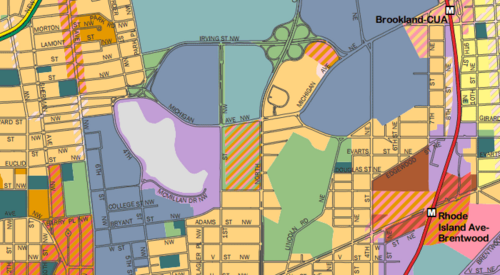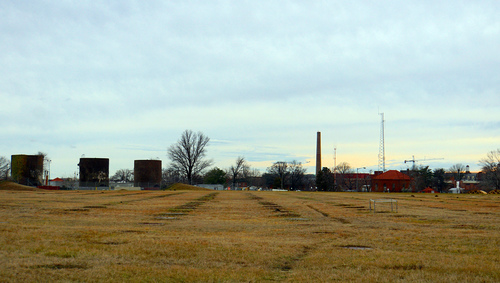A court just halted DC’s McMillan development
DC’s highest court just blocked development at the McMillan Sand Filtration Site. This is a setback for the city’s effort to turn an empty yet historic field, which previously served to filter drinking water, into a complex of housing, offices, and more active parks. This may not be end of the project, but it’s added some significant new hurdles.
The 25-acre site along North Capitol Street was established in 1905 as a way to purify the water of the Washington Aqueduct. The water ran through 25 underground vaults which filtered out impurities. But we don’t filter water this way any more, and in 1986 the federal government declared it surplus.
For years now, DC (which now owns the site) has been trying to work with a consortium of developers, called Vision McMillan Partners, who won a bidding process to redevelop the site. The plan would include 655 units of housing, office space for Children’s Hospital, and retail.
A park would keep part of the site open, and preserve the above-ground silos (the concrete tubes in the image above). The developers would also try to restore one of the vaults for people to explore and experience. Other vaults are not stable enough and could collapse, so they would be removed.
This week, DC officials held a groundbreaking ceremony for the project, but Thursday, a court opinion halted further progress.
What the court said
The court opinion hinged on two project approvals. First, the DC Zoning Commission, the hybrid federal-local board which has the final say (except this court) on zoning, approved this project. It was a Planned Unit Development, which is where a project gets some relief from zoning in exchange for community benefits.
Second, this site is a historic landmark. DC’s law allows demolishing some historic resources, either because of financial hardship or to construct a “project of special merit.” The Mayor’s Agent for Historic Preservation, the administrative judge who decides such cases, determined this did qualify as special merit.
A 3-judge panel of the Court of Appeals vacated both approvals and sent the project back for another opinion, and possibly more hearings, before both.
The zoning case is all about the Comp Plan
The DC Zoning Commission, which approved the project, is required to follow DC’s Comprehensive Plan. However, the Comp Plan is often compared to the Bible: it says whatever you want to read into it.
Contradictory policies in the Comp Plan simultaneously say, for instance, that DC needs more housing but should preserve open space; that established neighborhoods should be protected but there should be infill development; that there should be density near transit stations but then a map shows low density in that area.
In approving the project, the DC Zoning Commission traded off among some of these conflicting priorities. An while I am not a zoning attorney (and haven’t yet heard back from the ones I called), it appears the Court of Appeals understands this. However, the judges say that the Zoning Commission didn’t adequately explain why it was choosing to honor the policies it did over the ones it did not.
The court doesn’t prohibit high-density development
Some of the project would have larger buildings which qualify as “high density” in DC’s land use categories. One part of the Comp Plan is a map, the Future Land Use Map or FLUM, which shows density levels in different areas, and McMillan is not colored red for high density. It’s a combination of “moderate density commercial,” “medium density residential,” and “parks, recreation, and open space.”
Opponents argued that since some buildings are high density, those aren’t permitted here. However, the court disagreed, saying two things: First, on a large site like this, there could be some tall buildings and some short ones which essentially average out to moderate or medium density, and that’s okay. Second, the Zoning Commission has the perogative to weigh the map’s colors against the other provisions of the Comp Plan.
(Lawyers will parse how consistent this is with a recent case in Brookland, with two of the same three judges, where the court basically took the map literally and rejected a project for not matching its categories.)
However, the judges say that the Zoning Commission must explain its reasons for weighing some factors over others. The judges seem to take issue with some factors not being adequately explained. They have instructed the Zoning Commission to make another decision, potentially after more hearings, that better explains this:
The Commission stated that permitting high-density development on the northern portion of the site was “a critical and essential part of fulfilling the parks, recreation, and open space designation of the [FLUM], while at the same time achieving other elements of the Comprehensive Plan and the city’s strategic economic plan.”
[Friends of McMillan Park, a leading opposition group] argued before the Commission, however, that the other policies reflected in the Comprehensive Plan could be advanced even if development on the site were limited to medium- and moderate-density uses. The Commission neither provided a specific basis for concluding to the contrary nor stated reasons for giving greater weight to some policies than to others. We therefore vacate the Commission’s order and remand for further proceedings.
I am not a lawyer, but this McMillan decision says that that future zoning orders must explain away each and every comp plan inconsistency. pic.twitter.com/DsWHEBVwyS
— Alex Block (@alex_block) December 8, 2016
The court worries about environmental impacts and housing costs
Environmental Impact Statements are an important tool to ensure that governments don’t run roughshod over the environment. However, they require a lot of analysis by those advancing any project, and often that gives courts an opportunity to nitpick one or another of scores of analyses in the EIS. For example, the Purple Line, which is clearly better for the environment than everyone driving, was blocked for EIS deficiencies because the Maryland judge quibbled with ridership projections.
The court here may be adding some EIS-like procedure to approval of projects like this. The judges say that the Zoning Commission did consider environmental impacts, but not as thoroughly as it should have. That wasn’t their reason for remanding the project, but it points to a way these judges might find fault with a subsequent approval as well.
(The environmental benefit of dense development in the core of the city is that it lessens pressure to build sprawl in farms at the edge of the region. This is an area of some disagreement between Smart Growth environmentalists and others that fight for open space regardless of its location.)
Opponents further argued that the project would “accelerate gentrification, increase land values, and result in a net loss of affordable housing.” The opinion doesn’t get into the policy issues here, simply saying that the commission didn’t sufficiently address these either.
In reality, this project will not lead to a loss of affordable housing because it is creating more affordable housing. Having housing here is not going to push up housing prices nearby as compared to not having housing here. The opponents are making economic arguments that are intuitively true to some but contradicted by economic research, but it seems the judges identify with those arguments.
Ooof. PUD opponents can claim the project will cause gentrification, and it's up to the applicant to prove it won't?!?! pic.twitter.com/ef6N9uKbRd
— Alex Block (@alex_block) December 8, 2016
Is this “special merit”?
The court also vacated the Mayor’s Agent approval to demolish much of a historic resource to construct a “project of special merit.” This part of the ruling seems to pose an even higher hurdle for the project, as the court did not only find that the Mayor’s Agent failed to sufficiently explain himself.
Rather, the court disagreed with the overall definition of “special merit.” The Mayor’s Agent in essence found that the affordable housing, medical office needs, and other overall economic development value of the site outweighed the historic preservation value.
If I’m reading the opinion right, it seems this court disagrees. Special merit can be things like outstanding architecture and also a “specific feature of land planning.” That term is pretty vague, and the court is not at all convinced by the more general conclusion from the Mayor’s Agent:
“If the special-merit inquiry could appropriately focus on the “totality” of the benefits arising from a project,
then presumably the Mayor’s Agent should also take into account all of the project’s adverse impacts. Under such an approach, the Mayor’s Agent would function essentially as a second Zoning Commission, evaluating all of the benefits and adverse impacts associated with projects requiring a permit from the Mayor’s Agent. We conclude that the Preservation Act assigns the Mayor’s Agent the more discrete role of determining whether one or more specific attributes of a project, considered in isolation or in combination, rise to the level of special merit, thus triggering a balancing of those special-merit benefits against historic-preservation losses.
The developers weren’t clear about whether some cells could be preserved, at least according to the judges. The Mayor’s Agent dealt with that by requiring an additional step before the developers could demolish the cells, but the judges don’t feel that is sufficient.
Finally, the judges pose one more, perhaps quite big hurdle:
Among other things, an applicant seeking approval to demolish or subdivide a historic landmark bears the burden of showing that demolition or subdivision is “necessary.” … “The applicant must show that it considered alternatives to the total demolition of the historic building and that these alternatives were not reasonable.” Although an applicant need not demonstrate that there are no other feasible alternatives, an applicant “should be required to show that all reasonable alternatives were considered.”
In short, to be able to demolish a historic resource, the court is saying that the property owner needs to show that there is no “reasonable” other way to preserve the historic resource. This creates a high hurdle.
The preservation law doesn’t deal well with situations like this
Perhaps such a hurdle is appropriate. After all, if someone’s talking about demolishing a really special, historic building, these kinds of obstacles seem intuitively sensible.
But this isn’t a single, really significant building; it’s a giant 25-acre site. The preservation law seems somewhat ill-suited to such things, because it doesn’t provide for weighing various needs. If something is historic, it’s historic. There’s no “a little bit historic,” and the law doesn’t say the Mayor’s Agent can consider how the historic value weighs against the need for housing, tax revenue, medical office space, or active (rather than fenced-off) parks.
The Mayor’s Agent had, in other cases, used the “special merit” category for such situations, but this court decision throws that into doubt. DC makes it easier to designate things as historic than in some other places, but also somewhat easier to make changes as well; that may be changing.
If DC wants to be able to continue to add housing, it will eventually have to reckon with the twin trends of running lower on empty land and having more and more land designated as in historic districts or sites.
Historic preservation is valuable, but it needs to be weighed against other factors as well amid the various priorities for the city. If the court is going to reduce the Mayor’s Agent’s powers, perhaps the DC Council needs to amend the law to broaden them again.





